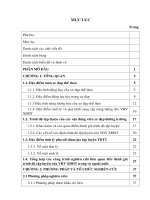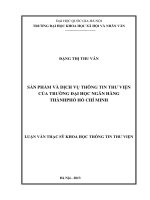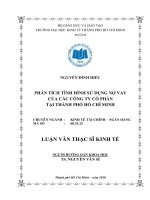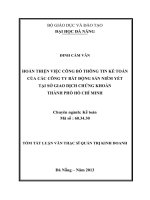Green construction performance - A study on stakeholders’ perceptions - TRƯỜNG CÁN BỘ QUẢN LÝ GIÁO DỤC THÀNH PHỐ HỒ CHÍ MINH
Bạn đang xem bản rút gọn của tài liệu. Xem và tải ngay bản đầy đủ của tài liệu tại đây (1.08 MB, 7 trang )
<span class='text_page_counter'>(1)</span><div class='page_container' data-page=1>
Green construction performance - A study on stakeholders’ perceptions
Le Thi Thanh Xuan1*<sub>, Nguyen Thanh Hoai Thu</sub>1
1<sub>School of Industrial Management, Ho Chi Minh City University of Technology (VNU-HCM), Vietnam </sub>
*<sub>Corresponding author: </sub>
ARTICLE INFO ABSTRACT
DOI:10.46223/HCMCOUJS.
econ.en.10.1.221.2020
Received: September 16th<sub>, 2019 </sub>
Revised: November 20th<sub>, 2019 </sub>
Accepted: April 20th<sub>, 2020 </sub>
Keywords:
green factories, LEED,
stakeholder, performance
This study is conducted to explore stakeholders’
understanding of the performance of green-certified factories in
the South of Vietnam. The study, based on the LEED Rating
system, employs a qualitative approach to address objectives and
in-depth interviews with 43 respondents including employees,
managers, and buyers of green factories to collect data. The
categories taken from LEED such as Water Efficiency, Indoor
environmental quality, Energy & atmosphere, Resources &
materials, Sustainable sites are used as the main analytical basis.
To tackle the research objective, the study aims (1) to explore
stakeholders’ awareness of green factories’ performance, and (2)
to propose recommendations to enhance the effectiveness of
green factories. The research findings show that, in general,
stakeholders are satisfied with the performance of green
factories. Nevertheless, there are some differences in the
awareness of stakeholders working in small and large size green
factories in a comparison with LEED. Finally, some suggestions
are proposed to enhance the performance of green factories.
1. Introduction
The construction industry today is one of the vital industries that has a profound impact on
the economy of any nation. This sector contributes significantly to the growth of nations where
governments make efforts to develop infrastructure related to commercial areas, transport, health,
and education sector. Currently, the rapid urbanization and industrialization with the increase of
construction development affect the global environment, especially in developing countries like
Vietnam. Related issues of energy usage, materials resources consumption, waste of production
and greenhouse gas release, etc. become the concerns of many countries. To respond to such an
important concern, since 1993, green construction has been developed worldwide as an effective
solution to resolve the problem (Kriss, 2014).
</div>
<span class='text_page_counter'>(2)</span><div class='page_container' data-page=2>
72
green building is already widely known in the construction sector currently, it is still a new phrase
among involved stakeholders. Many people have never heard of green buildings, many others are
using it but even do not know thoroughly about it. For investors and users, even if are aware of
green construction, many of them still do not properly understand the benefits that this construction
trend brings. Therefore, to evaluate and enhance the performance of green buildings, it is necessary
to find out how it is understood by different stakeholders, whether they know how the green
buildings operate and create benefits for them, and later on, for the environment.
The purpose of this present study is to explore the awareness of stakeholders of green
building on the performance of these buildings. Therefore, the study aims (1) to explore
stakeholders’ awareness on performances of green buildings following the instruction of LEED,
and (2) to propose recommendations to enhance the performance of green buildings.
2. Literature review
Green Building Terminology and Benefits of green factories
The US Green Building Council first introduced the concept of green building (green
construction) in 2007 (US Green Building Council, 2013). Accordingly, green building is a
construction designed, built, and operated throughout its life cycle following criteria:
Efficiently use energy, water, and other resources;
Protect occupant health and improving employee productivity;
Reduce waste, pollution and environmental degradation;
Bring long term economic benefits.
The World Green Building Council defines green building as: “A green building is a
building that, in its design, construction or operation, reduces or eliminates negative impacts, and
can create positive impacts, on our climate and natural environment. Green buildings preserve
precious natural resources and improve our quality of life.” (World Green Building Council, n.d.).
According to the Vietnam Green Building Council (VGBC), green building refers to works
that achieve high efficiency in the use of energy and material, minimize adverse impacts on the
environment and design to minimize the negative impacts of the built environment on human
health and the natural environment through:
Use energy, water, and other resources effectively;
Reduce emissions, pollution and negative impacts on the environment;
Protect user health and improve labor productivity;
Minimize waste, pollution, and environmental damage (Vietnam Green Building Council, n.d.).
Nguyen (2018) explained that whatever the definition, a green building ensures to limit
harms to the natural environment, save energy, use energy efficiently, and reduce the amount of
greenhouse emissions. This is the insight of “green” words in the green building concept, which
is the meaning of life, ecology, and environmental friendliness.
</div>
<span class='text_page_counter'>(3)</span><div class='page_container' data-page=3>
diversified range of research subjects are aimed at. While The awareness and Perception of Office
Property Users on Green Building in Lagos, Nigeria (Komolafe & Oyewole, 2018) conducted on
people who use offices, the 2007 Consumer Survey (Jamison, 2008). Article conducted in the US
examined the awareness of residents, i.e., the end-users, to see how they understand about green
building. The research of Sichali and Banda in 2017 discovered the green building perspective of
many objects including architect, quantity surveyor, clerk of works, project managers, engineer,
foremen, bricklayer, businessman, contractor, planer, carpenters, electricians, etc. (Sichali &
Banda, 2017). The other two remaining types of research in Africa (Omar et al., 2016) and (Nduka
& Ogunsanmi, 2015) measured the perception of consultants and construction professionals. In the
last ten year, the above-mentioned researches all covered LEED, a guideline for green building
assessment, as a reliable tool for measuring study subjects about green building awareness.
However, most of the studies did not mention factories, a type of construction that green buildings
are also directed to, besides civil engineering. In Vietnam, in the period 2015-2018, there were
about 40-50% of new LEED projects categorized in the industrial factory segment, which was quite
a relatively stable group (Le, 2019). Therefore, research on perceptions of users, owners, and buyers
revolving around green factories does not seem to be focused on research, especially in Vietnam.
Green buildings/green factories bring a lot of benefits. Firstly, Green factories help to
increase energy efficiency and reduce harmful, thereby contributing to environmental protection.
Secondly, green factories have an advantage of cost-saving in the operation process and increasing
productivity. Thirdly, green factories bring a huge benefit to the community, such as improving
public health, creating a healthy lifestyle and recreation.
The Leadership in Energy and Environmental Design (LEED) Rating System
LEED is one of the famous green building rating frameworks launched by the United State
green building Council in 2013. This document is used to identify, implement, and measure the
green building. Since its launch, LEED projects throughout the world have proved the benefits of
using green design techniques that decrease the harms of buildings and decrease natural balance
destruction.
By participating in LEED, parties together make a meaningful contribution to the green
building industry. By tracking green construction, they contribute to a growing body of knowledge
that will advance research in this rapidly evolving field. This will allow future projects to build on
the successes of current designs and bring innovations to the market. There are nine main
characteristics, which are called credits, these are (1) Integrative Process, (2) Location and
Transportation, (3) Sustainable Sites, (4) Water Efficiency, (5) Energy and Atmosphere, (6)
Materials and Resources, (7) Indoor Environmental Quality, (8) Innovation, (9) Regional Priority
(US Green Building Council, 2013).
(1) Integrative Process category is a list of requirements that need to be complied with by
the parties to ensure that the project is high-performance, cost-effective. This is a credit goes beyond
checklists and encourages integration during early design stages when clarifying the owner’s
aspirations and performance goals (US Green Building Council, 2013), not the operation stage. In
general, this credit requires checking items of energy-related systems and water-related systems,
which are more explicitly specified in other categories (Energy and Atmosphere, Water Efficiency),
for the interactions among all building and site systems. Therefore, this credit is rejected.
</div>
<span class='text_page_counter'>(4)</span><div class='page_container' data-page=4>
74
considers the features of the transportation facilities around the building and assesses the integrity
of these surrounding communities for user convenience. The criteria of its (Walking & bicycling
distance and Total vehicle parking capacity) are partly mentioned in the Sustainable Sites category.
Additionally, transport infrastructure features outside the factory were fixed before the
construction started and could not be changed, so this credit is rejected.
(3) Sustainable Sites category rewards solutions about the environment surrounding the
building, with relationships among buildings, ecosystems, and ecosystem services. In general, it
focuses on restoring project site elements, integrating the site with local and regional ecosystems,
and preserving the biodiversity that natural systems rely on (US Green Building Council, 2013).
(4) Water Efficiency category examines both outdoor and indoor use of water to recognize
the use of non-potable and alternative sources of water. As a result, the credit encourages parties
to take advantage of every opportunity to significantly reduce total water use (US Green Building
Council, 2013).
(5) Energy and Atmosphere category focuses on addressing energy use reduction,
energy-efficient design strategies, and renewable energy resources, the recent problems of unsustainable
nonrenewable energy sources. Strategies like passive heating and cooling, natural ventilation are
some measures to reduce a building’s energy use (US Green Building Council, 2013).
(6) Materials and Resources category aims at minimizing the energy used and impacts of
extraction, processing, transport, maintenance, and disposal of building materials.
(7) Indoor Environmental Quality category addresses the design strategies and
environmental factors including air quality, lighting quality, acoustic design, controlled over
people’s surroundings that affect the way they learn and work (US Green Building Council, 2013).
(8) Innovation category is to recognize projects for innovative building features and
sustainable building practices and strategies (US Green Building Council, 2013). In fact, during
the rating process of a green building, this credit is determined as the extra-score rewarding which
buildings that performance that greatly exceeds what is required in an existing LEED. This credit
was not credited to the scorecards of the two factories in this study, so it was rejected.
(9) Regional Priority is a criterion built on each different area’s characteristics. Because
some environmental issues are location-specific, USGBC has worked with local experts to identify
RP credits for every location — and every rating system — within local or national boundaries
(US Green Building Council, 2013). Different LEED project types may be associated with
different environmental consent, so each rating system has its Regional Priority credits. Hence,
this category is rejected as it cannot use as a standard factor.
</div>
<span class='text_page_counter'>(5)</span><div class='page_container' data-page=5>
Figure 1. Adjusted LEED rating tool
3. Methodology
To explore the awareness of stakeholders on the performance of green factories, a
qualitative approach is employed. In particular, in-depth interviews and focus groups are the main
techniques to collect data. Based on 5 chosen dimensions of LEED rating tool, interview questions
are proposed to investigate interviewees’ opinions of conditions and performance of their (green)
factories. In detail, interviewees are asked about their thinking, as well as whether they are satisfied
with each of the construction solutions applied in factories. All questions are adjusted in words to
be compatible with the situation of each participant. This section aims to obtain the way how
participants understand about green building practices and the extent of the importance of green
building in construction. Depending on participants, characteristics are added or rejected
accordingly. For instance, the technical factors will not be included in questions for workers.
This research conducted interviews in two certified green factories, which have been in
operation for about a year at the time the research conducted. They are two garment factories
located in the South of Vietnam. Interviewees from these two factories include factory managers,
buyers, and employees as the three key stakeholders. Factory managers could be either directors
or managers working in the factories. Buyers are enterprises taking the partnership with the two
factories by using the factory’s infrastructure. Employees are workers and officers currently
working for these two factories.
Participants in the interview include workers and employees working at the factory; plant
manager - the person most responsible for running the plant, the middle manager; and
representative of the factories’ buyer. Of the 43 participants, 25 are workers in two factories
(accounting for one-third of total participants), 12 are employees, who carried out administrative
tasks at the factory. Of the remaining 6 interviewees, 4 are members of the management of two
factories, and 2 are buyers’ representatives.
A summary of the two sampled factories
</div>
<span class='text_page_counter'>(6)</span><div class='page_container' data-page=6>
76
Figure 2. Factory A simulation model
Factory B is one of the 1st manufacturing factories received green building certification. It
is manufacturing sportwears for Decathlon to export. It has an area of 22,300 m2. The factory
includes sewing lines, cutting area, semi-finished goods area, components warehouse, office area,
canteen, and green area in DongNai province. (Figure 3).
Figure 3. Factory B simulation model
4. Stakeholders’ opinion of factories’ performance followed leed
4.1. Water efficiency
In terms of ease of use, all interviewed workers and officers of Factory A and Factory B
answered that the factories’ water equipments are very modern and easy to use.
"... Sanitary appliances are of course easy to use, no broken or low quality" (O A.2)
Relating to consumed water, not only the owner but also managers in Factory A confirmed
that the factory reduced a significant amount of water consumption thanks to sanitary equipment.
Both factories carry out re-use systems of wastewater, rainwater collection systems as a main
solution to help save water. Harvesting rainwater can reduce the use of drinking water for
landscape irrigation. The managers of both factories said that recycling and reusing wastewater
through water harvesting and recycling systems had greatly contributed to saving large amounts
of monthly-consumed water.
"In fact, those solutions, especially the water treatment system, helped save a lot water,
in the first month only using pure water, we had to pay 70 million for a water
consumption billing; when we started reusing water the following months, it was
dropped down about 14 to 15 million. So it saves water successfully" (Manager A.1)
</div>
<span class='text_page_counter'>(7)</span><div class='page_container' data-page=7>
water at the factory" (O B.3).
Currently, no buyers put strict demands on the level of the factory’s water consumption.
Nike stated that the supplier minimizes freshwater withdrawals and discharges wastewater in
compliance with relevant local laws, regulations, and Nike standards. Supplier strives to be a good
water steward by understanding and managing its water risk and promoting the continuous
reduction and efficient use in its operations. Both Factory A and Factory B are aiming at this goal.
As mentioned above, all facilities such as water harvesting system, wastewater recycling system,
using water-absorbing grass brick, etc. To reduce the use of potable water effectively. On the other
hand, brands are particularly concerned with how factories discharge of wastewater into the
environment, they both have strict guideline regulations on discharge conditions, which currently
both two factories still have not discharged any production wastewater.
In general, both factories have almost the same investment items in terms of water use
category, which is the same in the understanding between workers and employees, even factory
owners and buyers as well.
4.2. Indoor environmental quality
This dimension includes Lighting, Thermal comfort, Workshop’s air ventilation, Office’s
viewing, Acoustic performance, Restroom atmosphere, and Canteen atmosphere. With this
dimension, the requirement from buyers are clearly stated:
“All of the suppliers need to provide a safe workplace setting and takes necessary
steps to prevent accidents and injury arising out of, linked with or occurring in
the course of work or as a result of the operation of supplier’s facilities" (Nike
Global, 2017).
In general, all sub-dimensions are serving well. Stakeholders’ opinions of these are also
positive. For example, regarding to Lighting, workers and officers at both factories are satisfied.
Both factories have tried to reduce the pollution light as much as possible, even though they are
applied to different systems. Factory A is using LED light as the main light source, meanwhile,
Factory B is employing the flexibility between artificial light and sunlight use. One of the workers
in Factory B said:
"Because of taking natural light through the roof and through windows directly,
artificial light is almost no need" (W B.7).
According to a manager at Factory B: "Normally, the lights are turned on from 8 am, turned
off at 9 am to save the electricity. In general, when the sun shines, we turn it off. There are the sun
optic sheets absorbing sunlight, which are more useful for the factory than normal roofs" (M B.1).
Or a manager at Factory A said: “In general, here we use LED light so we don’t need to
worry about the lack of light, not even too bright” (M A.1).
</div>
<!--links-->









